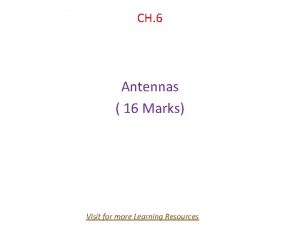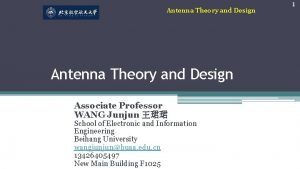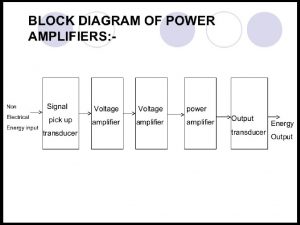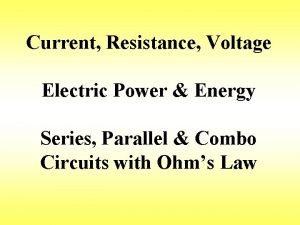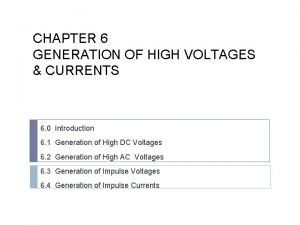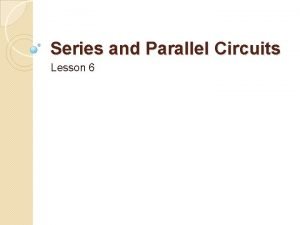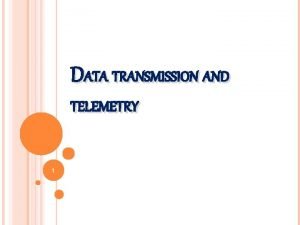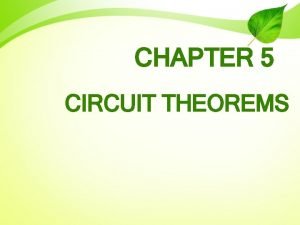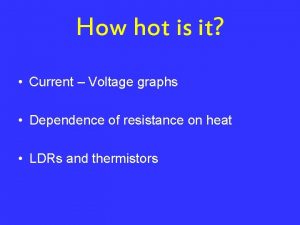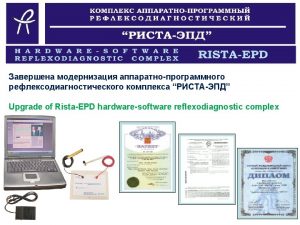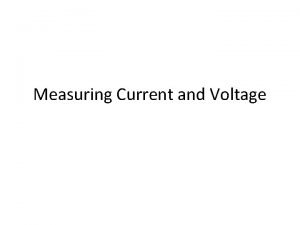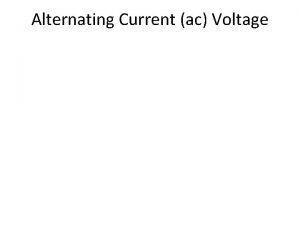Chapter 3 Voltage and Current Laws Fig 3

















- Slides: 17

Chapter 3 Voltage and Current Laws Fig. 3. 1 “A circuit containing three nodes and five branches …” Fig. 3. 2 Example node to illustrate the application of KCL. User Note: Fig. 3. 19 “Addition of multiple voltage or current sources. ” Run View Show under the Slide Show menu to enable slide selection. Fig. 3. 20 Examples of circuits with multiple sources, . . . Fig. 3. 22 (a) Series combination of N resistors. Fig. 3. 25 (a) A circuit with N resistors in parallel. Fig. 3. 30 An illustration of voltage division. Fig. 3. 32 Circuit for Practice Problem 3. 12. Fig. 3. 33 An illustration of current division. Fig. 3. 100 “Determine the current Ix if I 1 = 100 m. A. ” Engineering Circuit Analysis Sixth Edition W. H. Hayt, Jr. , J. E. Kemmerly, S. M. Durbin Copyright © 2002 Mc. Graw-Hill, Inc. All Rights Reserved.

(a) A circuit containing three nodes and five branches. (b) Node 1 is redrawn to look like two nodes; it is still one node. W. H. Hayt, Jr. , J. E. Kemmerly, S. M. Durbin, Engineering Circuit Analysis, Sixth Edition. Copyright © 2002 Mc. Graw-Hill. All rights reserved.

Figure 3. 2 W. H. Hayt, Jr. , J. E. Kemmerly, S. M. Durbin, Engineering Circuit Analysis, Sixth Edition. Copyright © 2002 Mc. Graw-Hill. All rights reserved.



(a) Series connected voltage sources can be replaced by a single source. (b) Parallel current sources can be replaced by a single source. W. H. Hayt, Jr. , J. E. Kemmerly, S. M. Durbin, Engineering Circuit Analysis, Sixth Edition. Copyright © 2002 Mc. Graw-Hill. All rights reserved.

Examples of circuits with multiple sources, some of which are “illegal” as they violate Kirchhoff’s laws. W. H. Hayt, Jr. , J. E. Kemmerly, S. M. Durbin, Engineering Circuit Analysis, Sixth Edition. Copyright © 2002 Mc. Graw-Hill. All rights reserved.



(a) Series combination of N resistors. (b) Electrically equivalent circuit. W. H. Hayt, Jr. , J. E. Kemmerly, S. M. Durbin, Engineering Circuit Analysis, Sixth Edition. Copyright © 2002 Mc. Graw-Hill. All rights reserved.

Beginning with a simple KCL equation, or Thus, A special case worth remembering is (a) A circuit with N resistors in parallel. (b) Equivalent circuit. W. H. Hayt, Jr. , J. E. Kemmerly, S. M. Durbin, Engineering Circuit Analysis, Sixth Edition. Copyright © 2002 Mc. Graw-Hill. All rights reserved.

We may find v 2 by applying KVL and Ohm’s law: so An illustration of voltage division. Thus, or For a string of N series resistors, we may write: W. H. Hayt, Jr. , J. E. Kemmerly, S. M. Durbin, Engineering Circuit Analysis, Sixth Edition. Copyright © 2002 Mc. Graw-Hill. All rights reserved.

Use voltage division to determine vx in the adjacent circuit. W. H. Hayt, Jr. , J. E. Kemmerly, S. M. Durbin, Engineering Circuit Analysis, Sixth Edition. Copyright © 2002 Mc. Graw-Hill. All rights reserved.

The current flowing through R 2 is or An illustration of current division. For a parallel combination of N resistors, the current through Rk is W. H. Hayt, Jr. , J. E. Kemmerly, S. M. Durbin, Engineering Circuit Analysis, Sixth Edition. Copyright © 2002 Mc. Graw-Hill. All rights reserved.

Determine the current Ix if I 1 = 100 m. A. W. H. Hayt, Jr. , J. E. Kemmerly, S. M. Durbin, Engineering Circuit Analysis, Sixth Edition. Copyright © 2002 Mc. Graw-Hill. All rights reserved.


 Kathy coover
Kathy coover Line current and phase current
Line current and phase current Step voltage and touch voltage
Step voltage and touch voltage Peak to rms conversion
Peak to rms conversion Medium voltage range
Medium voltage range Types of ac voltage controller
Types of ac voltage controller Mig voltage chart
Mig voltage chart Parallel vs series
Parallel vs series Current and voltage distribution in antenna
Current and voltage distribution in antenna Current and voltage distribution in antenna
Current and voltage distribution in antenna Voltage current energy
Voltage current energy Difference between voltage and power amplifier
Difference between voltage and power amplifier Power with resistance and voltage
Power with resistance and voltage Generation of high voltage
Generation of high voltage Lesson 6 current voltage and resistance in a circuit
Lesson 6 current voltage and resistance in a circuit Types of telemetry
Types of telemetry Source absorption theorem
Source absorption theorem Thermistor current voltage graph
Thermistor current voltage graph








